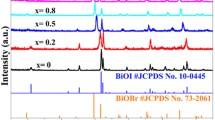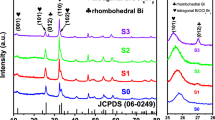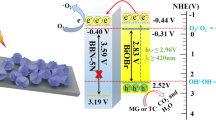Abstract
In this study, a facile alcoholysis method was developed to synthesize BiOCl x Br1−x nanoplates at room temperature and atmospheric pressure. In this route, strong acid or alkaline environment was absolutely avoided to realize the high exposure of {001} crystal facets. The regular changes in XRD peaks and cell parameters as a function of the Br content strongly declared that the obtained BiOCl x Br1−x products belonged to a group of solid solutions. The 2D nanosheets with in-plane wrinkles were clearly observed in TEM images. Interestingly, as the Br content increased, band gaps of BiOCl x Br1−x solid solutions gradually decreased. The photocatalytic degradation of RhB under simulated sunlight irradiation indicated that BiOCl0.5Br0.5 had the best photocatalytic activity. From the viewpoint of crystal chemistry, the photocatalytic activity of BiOCl x Br1−x solid solutions was closely related with the exposure amount of {001} facets, interlayer spacing of (001) plane and energy-level position of valence band.
Similar content being viewed by others
References
Fujishima A, Honda K. Electrochemical photolysis of water at a semiconductor electrode. Nature, 1972, 238(5358): 37–38
Daghrir R, Drogui P, Robert D. Modified TiO2 for environmental photocatalytic application: a review. Industrial & Engineering Chemistry Research, 2013, 52(10): 3581–3599
Kuo Y L, Su T L, Kung F C, et al. A study of parameter setting and characterization of visible-light driven nitrogen-modified commercial TiO2 photocatalysts. Journal of Hazardous Materials, 2011, 190(1–3): 938–944
Chen X, Liu L, Huang F. Black titanium dioxide (TiO2) nanomaterials. Chemical Society Reviews, 2015, 44(7): 1861–1885
Kumar S G, Devi L G. Review on modified TiO2 photocatalysis under UV/visible light: selected results and related mechanisms on interfacial charge carrier transfer dynamics. The Journal of Physical Chemistry A, 2011, 115(46): 13211–13241
Nowotny J, Alim M A, Bak T, et al. Defect chemistry and defect engineering of TiO2-based semiconductors for solar energy conversion. Chemical Society Reviews, 2015, 44(23): 8424–8442
Schneider J, Matsuoka M, Takeuchi M, et al. Understanding TiO2 photocatalysis: mechanisms and materials. Chemical Reviews, 2014, 114(19): 9919–9986
Kapilashrami M, Zhang Y, Liu Y S, et al. Probing the optical property and electronic structure of TiO2 nanomaterials for renewable energy applications. Chemical Reviews, 2014, 114(19): 9662–9707
Meng X C, Zhang Z S. Bismuth-based photocatalytic semiconductors: introduction, challenges and possible approaches. Journal of Molecular Catalysis A: Chemical, 2016, 423: 533–549
Bhachu D S, Moniz S J A, Sathasivam S, et al. Bismuth oxyhalides: synthesis, structure and photoelectrochemical activity. Chemical Science, 2016, 7(8): 4832–4841
Li G, Qin F, Wang R, et al. BiOX (X = Cl, Br, I) nanostructures: mannitol-mediated microwave synthesis, visible light photocatalytic performance, and Cr(VI) removal capacity. Journal of Colloid and Interface Science, 2013, 409: 43–51
Keramidas K G, Voutsas G P, Rentzeperis P I. The crystal structure of BiOCl. Zeitschrift fur Kristallographie, 1993, 205: 35–40
Bannister F A, Hey M H. The crystal-structure of the bismuth oxyhalides. Mineralogical Magazine, 1935, 24(149): 49–58
Li J, Yu Y, Zhang L. Bismuth oxyhalide nanomaterials: layered structures meet photocatalysis. Nanoscale, 2014, 6(15): 8473–8488
Xu Z F, Hao W C, Zhang Q F, et al. Indirect-direct band transformation of few-layer BiOCl under biaxial strain. Journal of Physical Chemistry C, 2016, 120(16): 8589–8594
Cheng H, Huang B, Dai Y. Engineering BiOX (X = Cl, Br, I) nanostructures for highly efficient photocatalytic applications. Nanoscale, 2014, 6(4): 2009–2026
Yin S, Di J, Li M, et al. Ionic liquid-assisted synthesis and improved photocatalytic activity of p-n junction g-C3N4/BiOCl. Journal of Materials Science, 2016, 51(10): 4769–4777
Tripathi G K, Kurchania R. Effect of doping on structural, optical and photocatalytic properties of bismuth oxychloride nanomaterials. Journal of Materials Science Materials in Electronics, 2016, 27(5): 5079–5088
Keller E, Krämer V. A strong deviation from Vegard’s rule: X-ray powder investigations of the three quasi-binary phase systems BiOX–BiOY (X, Y = Cl, Br,I). Zeitschrift für Naturforschung B, 2014, 60(12): 1255–1263
Gnayem H, Sasson Y. Hierarchical nanostructured 3D flowerlike BiOClxBr1–x semiconductors with exceptional visible light photocatalytic activity. ACS Catalysis, 2013, 3(2): 186–191
Mao X M, Fan C M. Rhodamine B from water. International Journal of Minerals Metallurgy and Materials, 2013, 20(11): 1089–1096
Zhang X, Wang L W, Wang C Y, et al. Synthesis of BiOClxBr1–x nanoplate solid solutions as a robust photocatalyst with tunable band structure. Chemistry, 2015, 21(33): 11872–11877
Du D D, Li W J, Chen S S, et al. Synergistic degradation of rhodamine B on BiOClxBr1–x sheets by combined photosensitization and photocatalysis under visible light irradiation. New Journal of Chemistry, 2015, 39(4): 3129–3136
Li T B, Chen G, Zhou C, et al. New photocatalyst BiOCl/BiOI composites with highly enhanced visible light photocatalytic performances. Dalton Transactions, 2011, 40(25): 6751–6758
Xiao X, Hao R, Liang M, et al. One-pot solvothermal synthesis of three-dimensional (3D) BiOI/BiOCl composites with enhanced visible-light photocatalytic activities for the degradation of bisphenol-A. Journal of Hazardous Materials, 2012, 233–234: 122–130
Dong F, Sun Y, Fu M, et al. Room temperature synthesis and highly enhanced visible light photocatalytic activity of porous BiOI/BiOCl composites nanoplates microflowers. Journal of Hazardous Materials, 2012, 219–220: 26–34
Sun L M, Xiang L, Zhao X, et al. Enhanced visible-light photocatalytic activity of BiOI/BiOCl heterojunctions: key role of crystal facet combination. ACS Catalysis, 2015, 5(6): 3540–3551
Yang C Y, Li F, Zhang M, et al. Preparation and first-principles study for electronic structures of BiOI/BiOCl composites with highly improved photocatalytic and adsorption performances. Journal of Molecular Catalysis A: Chemical, 2016, 423: 1–11
Jia Z F, Wang F M, Xin F, et al. Simple solvothermal routes to synthesize 3D BiOBrxI1–x microspheres and their visible-lightinduced photocatalytic properties. Industrial & Engineering Chemistry Research, 2011, 50(11): 6688–6694
Lin L, Huang M H, Long L P, et al. Fabrication of a threedimensional BiOBr/BiOI photocatalyst with enhanced visible light photocatalytic performance. Ceramics International, 2014, 40(8): 11493–11501
Zheng C, Cao C, Ali Z. In situ formed Bi/BiOBrxI1–x heterojunction of hierarchical microspheres for efficient visiblelight photocatalytic activity. Physical Chemistry Chemical Physics, 2015, 17(20): 13347–13354
Zhang X, Wang C Y, Wang L W, et al. Fabrication of BiOBrxI1–x photocatalysts with tunable visible light catalytic activity by modulating band structures. Scientific Reports, 2016, 6: 22800
Ou M Y, Dong F, Zhang W, et al. Efficient visible light photocatalytic oxidation of NO in air with band-gap tailored (BiO)2CO3–BiOI solid solutions. Chemical Engineering Journal, 2014, 255: 650–658
Ding J, Dai Z, Qin F, et al. Z-scheme BiO1–xBr/Bi2O2CO3 photocatalyst with rich oxygen vacancy as electron mediator for highly efficient degradation of antibiotics. Applied Catalysis B: Environmental, 2017, 205: 281–291
Tian F, Xiong J Y, Zhao H P, et al. Mannitol-assisted solvothermal synthesis of BiOCl hierarchical nanostructures and their mixed organic dye adsorption capacities. CrystEngComm, 2014, 16(20): 4298–4305
Tian F, Zhang Y F, Li G F, et al. Thickness-tunable solvothermal synthesis of BiOCl nanosheets and their photosensitization catalytic performance. New Journal of Chemistry, 2015, 39(2): 1274–1280
Li G F, Qin F, Yang H, et al. Facile microwave synthesis of 3D flowerlike BiOBr nanostructures and their excellent CrVI removal capacity. European Journal of Inorganic Chemistry, 2012, (15): 2508–2513
Cui P Z, Wang J L, Wang Z M, et al. Bismuth oxychloride hollow microspheres with high visible light photocatalytic activity. Nano Research, 2016, 9(3): 593–601
Xiong J Y, Cheng G, Qin F, et al. Tunable BiOCl hierarchical nanostructures for high-efficient photocatalysis under visible light irradiation. Chemical Engineering Journal, 2013, 220: 228–236
Chen H B, Yu X, Zhu Y, et al. Controlled synthesis of {001} facets-dominated dye-sensitized BiOCl with high photocatalytic efficiency under visible-light irradiation. Journal of Nanoparticle Research, 2016, 18(8): 225
Li J, Zhang L, Li Y, et al. Synthesis and internal electric field dependent photoreactivity of Bi3O4Cl single-crystalline nanosheets with high {001} facet exposure percentages. Nanoscale, 2014, 6(1): 167–171
Lei Y Q, Wang G H, Song S Y, et al. Synthesis, characterization and assembly of BiOCl nanostructure and their photocatalytic properties. CrystEngComm, 2009, 11(9): 1857–1862
Liu Y, Son W J, Lu J, et al. Composition dependence of the photocatalytic activities of BiOCl1–xBrx solid solutions under visible light. Chemistry, 2011, 17(34): 9342–9349
Li H, Shi J, Zhao K, et al. Sustainable molecular oxygen activation with oxygen vacancies on the 001 facets of BiOCl nanosheets under solar light. Nanoscale, 2014, 6(23): 14168–14173
Feng H, Xu Z, Wang L, et al. Modulation of photocatalytic properties by strain in 2D BiOBr nanosheets. ACS Applied Materials & Interfaces, 2015, 7(50): 27592–27596
Xu H Y, Wu L C, Jin L G, et al. Combination mechanism and enhanced visible-light photocatalytic activity and stability of CdS/ g-C3N4 heterojunctions. Journal of Materials Science and Technology, 2017, 33(1): 30–38
Li J, Li H, Zhan G, et al. Solar water splitting and nitrogen fixation with layered bismuth oxyhalides. Accounts of Chemical Research, 2017, 50(1): 112–121
Xiong J Y, Cheng G, Li G F, et al. Well-crystallized square-like 2D BiOCl nanoplates: mannitol-assisted hydrothermal synthesis and improved visible-light-driven photocatalytic performance. RSC Advances, 2011, 1(8): 1542–1553
Jiang J, Zhao K, Xiao X, et al. Synthesis and facet-dependent photoreactivity of BiOCl single-crystalline nanosheets. Journal of the American Chemical Society, 2012, 134(10): 4473–4476
Zhao J L, Lv X W, Wang X X, et al. Fabrication of BiOX (X = Cl, Br, and I) nanosheeted films by anodization and their photocatalytic properties. Materials Letters, 2015, 158: 40–44
Jia M, Hu X, Wang S, et al. Photocatalytic properties of hierarchical BiOXs obtained via an ethanol-assisted solvothermal process. Journal of Environmental Sciences, 2015, 35(9): 172–180
Zhang Y Y, Sun X G, Yang G Z, et al. Preparation and characterization of bifunctional BiOClxIy solid solutions with excellent adsorption and photocatalytic abilities for removal of organic dyes. Materials Science in Semiconductor Processing, 2016, 41: 193–199
Zhang W D, Zhang Q, Dong F. Visible-light photocatalytic removal of NO in air over BiOX (X = Cl, Br, I) single-crystal nanoplates prepared at room temperature. Industrial & Engineering Chemistry Research, 2013, 52(20): 6740–6746
Shang J, Hao W C, Lv X J, et al. Bismuth oxybromide with reasonable photocatalytic reduction activity under visible light. ACS Catalysis, 2014, 4(3): 954–961
Tian F, Zhao H P, Dai Z, et al. Mediation of valence band maximum of BiOI by Cl incorporation for improved oxidation power in photocatalysis. Industrial & Engineering Chemistry Research, 2016, 55(17): 4969–4978
Acknowledgements
We express our great appreciation for the financial support of the Program for New Century Excellent Talents in Heilongjiang Provincial Universities (1253-NCET-010).
Author information
Authors and Affiliations
Corresponding author
Rights and permissions
About this article
Cite this article
Xu, HY., Han, X., Tan, Q. et al. Crystal-chemistry insight into the photocatalytic activity of BiOCl x Br1−x nanoplate solid solutions. Front. Mater. Sci. 11, 120–129 (2017). https://doi.org/10.1007/s11706-017-0379-7
Received:
Accepted:
Published:
Issue Date:
DOI: https://doi.org/10.1007/s11706-017-0379-7




